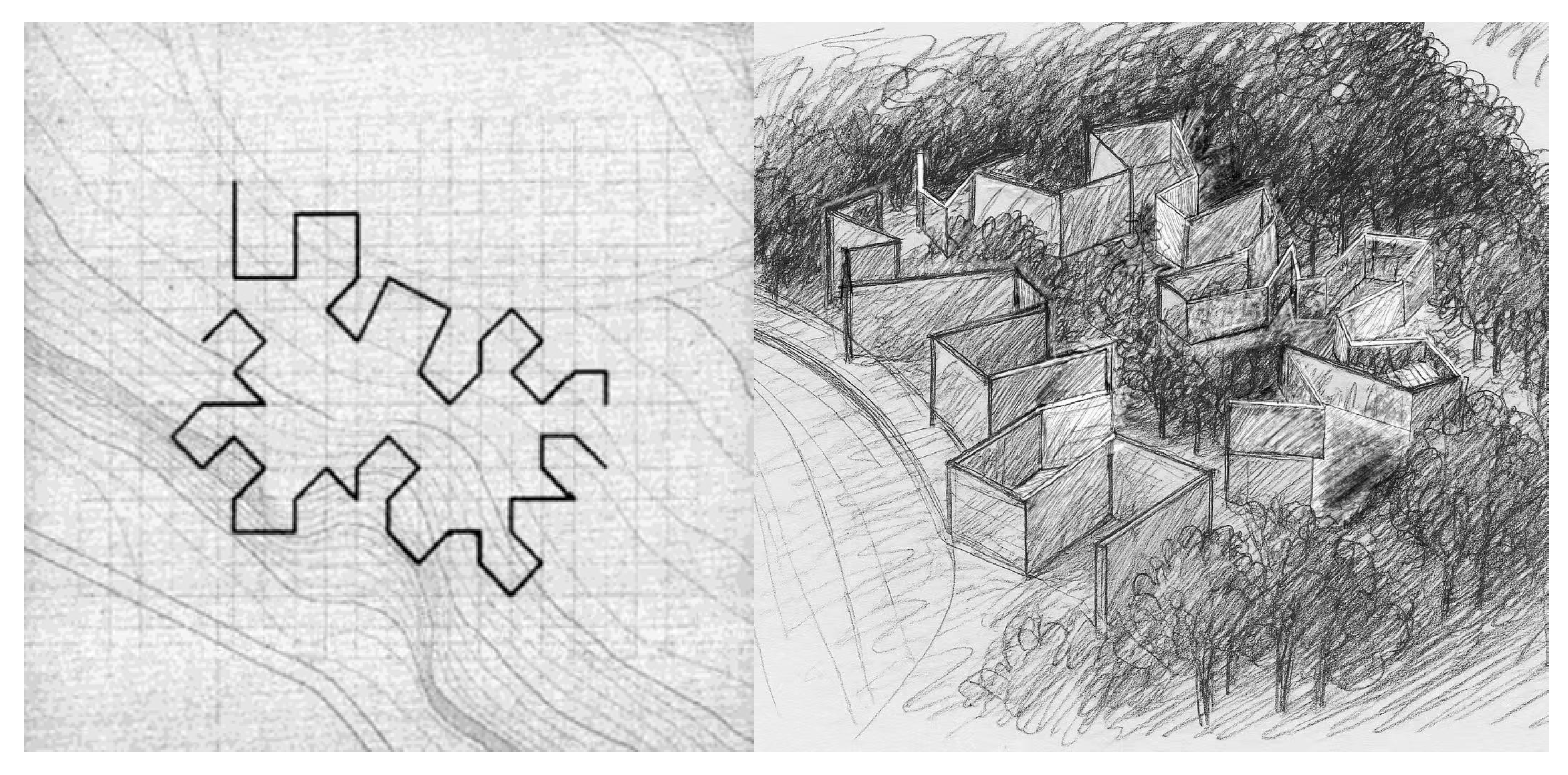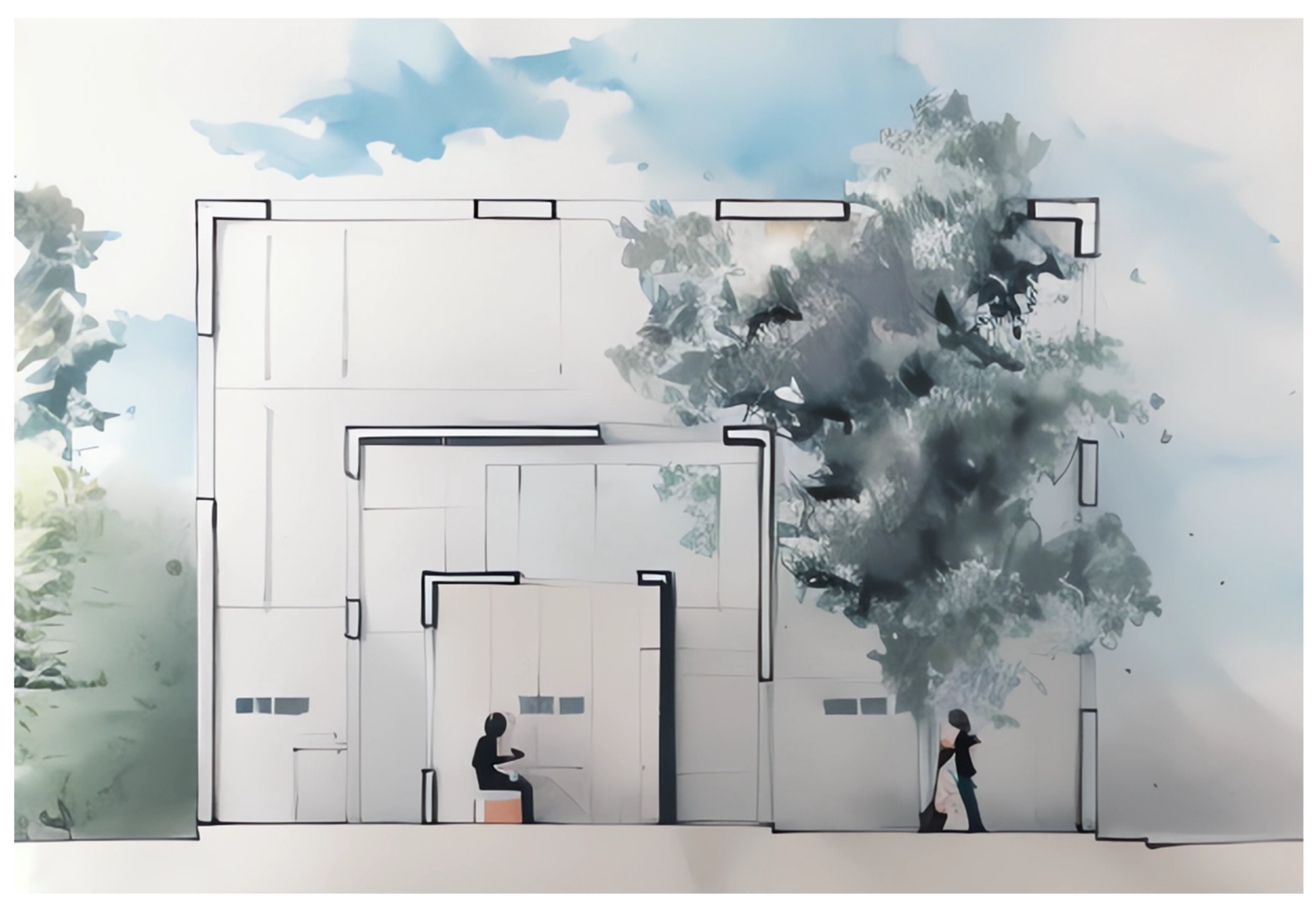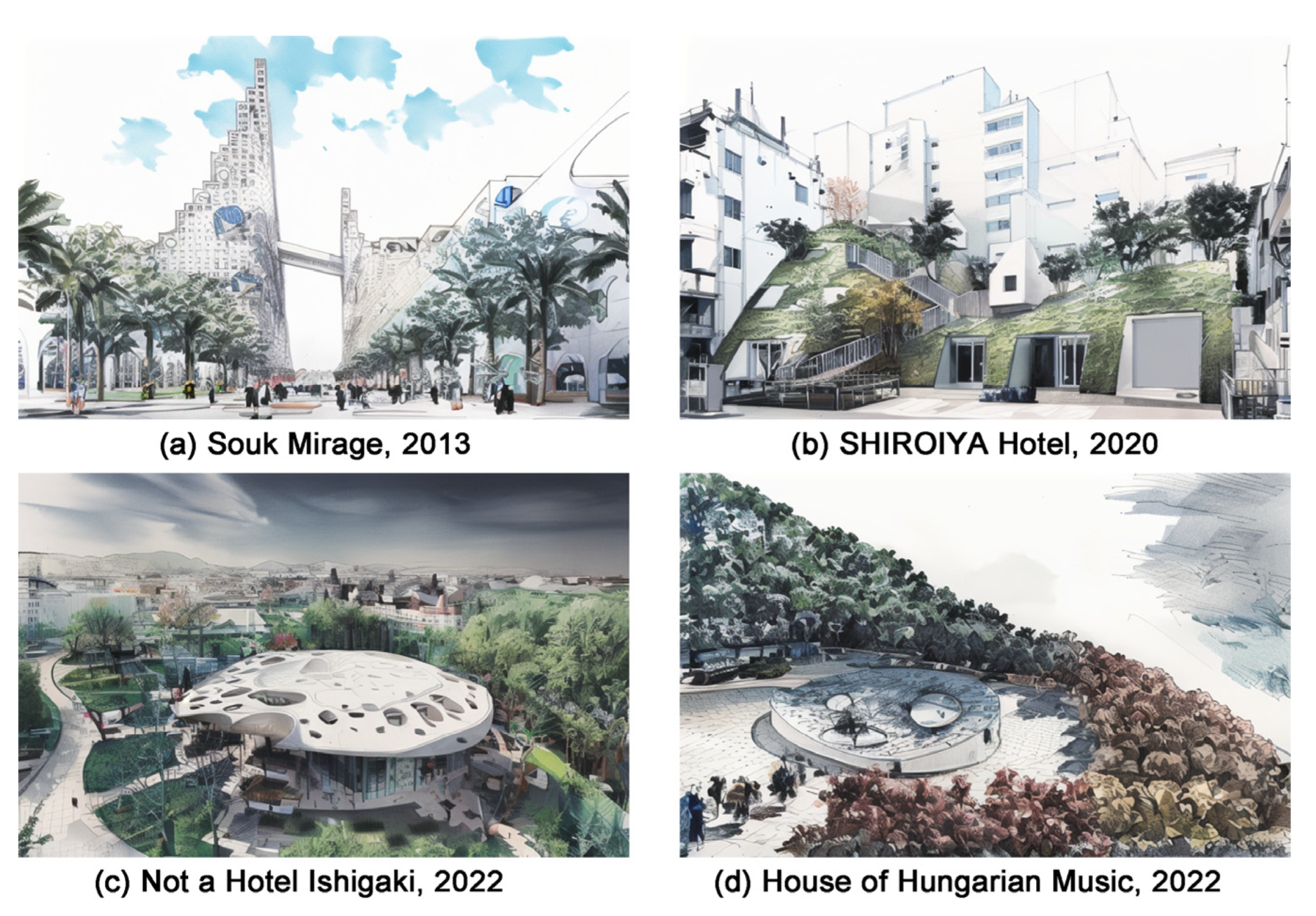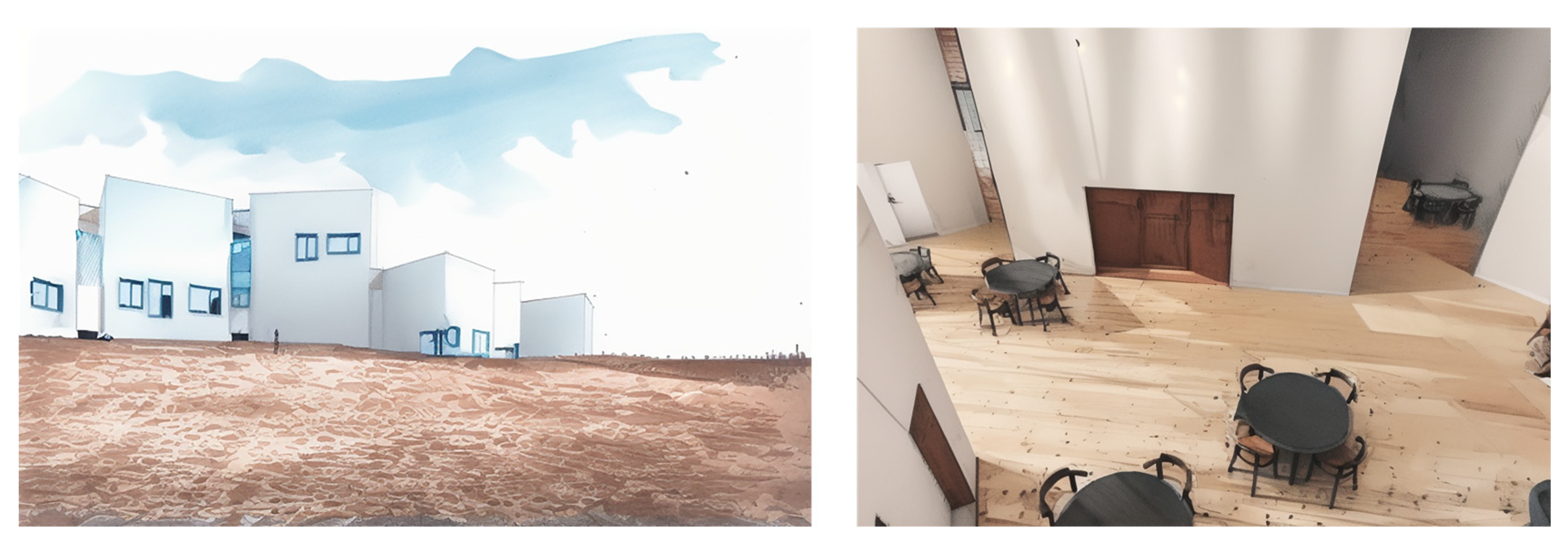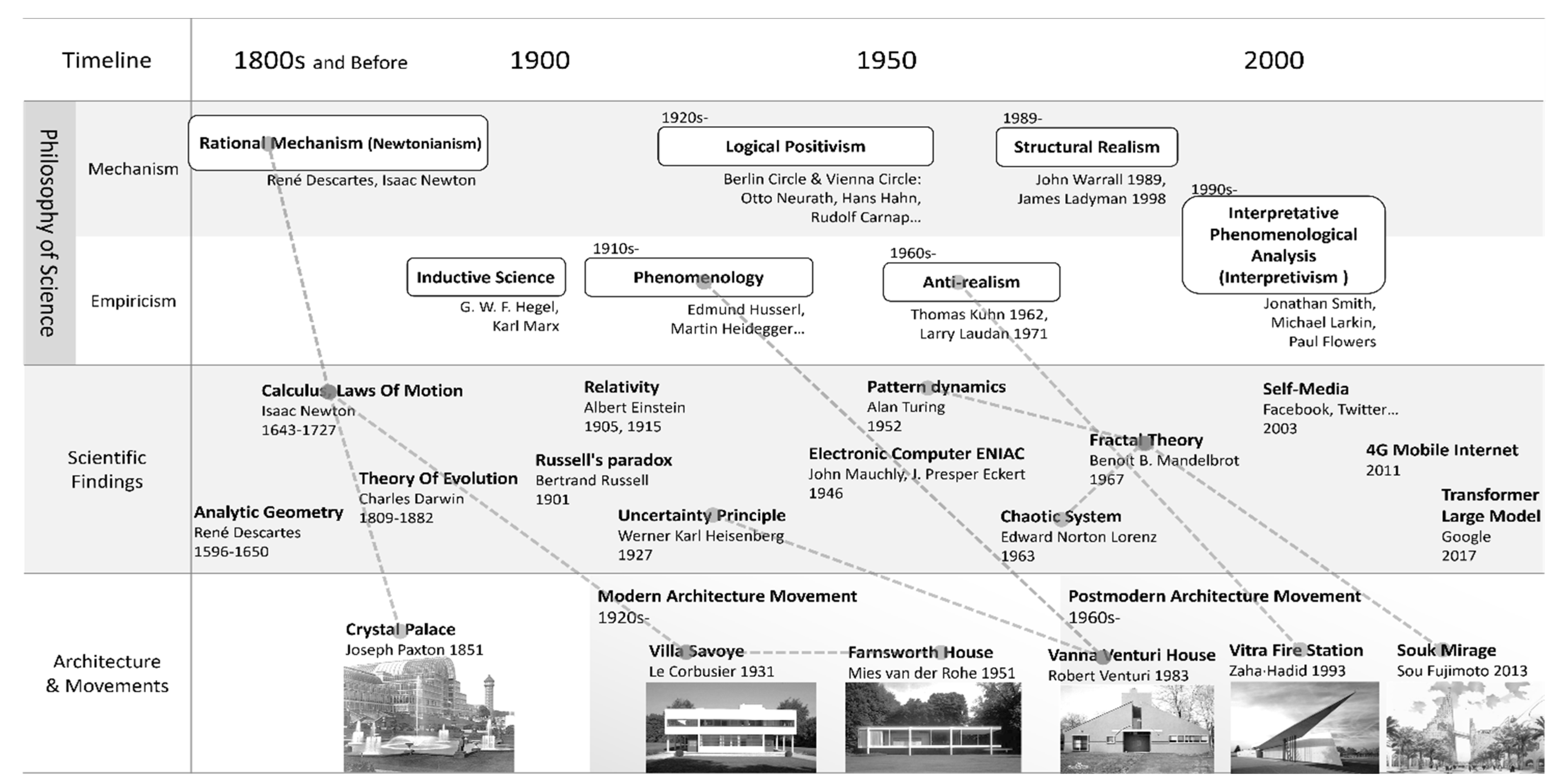1. Introduction
Science, as the primary driving force of social development since modern times, has had a profound impact on modern architecture, offering new possibilities for construction while influencing architectural theory. The philosophy of science has also played a role in shaping architectural movements and trends. Examining the relationship between science and architecture provides a unique perspective on architectural history and can offer insights into future trends.
The works of renowned Japanese architect Sou Fujimoto serve as ideal case studies for examining the relational chain from “philosophy of science” to “architectural works”. His designs often embody a complete logical progression from “scientific discoveries and philosophical theories” to “spatial form”. In his architectural practice, he frequently identifies a clear theoretical framework rooted in the philosophy of science and successfully translates these abstract concepts into spatial and physical forms. Born in Hokkaido, Japan, in 1971, Sou Fujimoto graduated from the University of Tokyo in 1994 and established Sou Fujimoto Architects in 2000. He is considered a modern leading figure in Japanese architecture alongside SANAA, Kengo Kuma, and Toyo Ito. His works are known for their unique communication and deep philosophical connotations that have resonated globally. Some have even commented that “Sou Fujimoto has taken architecture a step forward” [
1]. His creations incorporate modern scientific achievements and philosophies to form a unique architectural design style with specific ideological connotations.
To explore the relationship between the philosophy of science and architecture, this article is structured in three parts. The first part reviews the historical trajectory of the coordinated development between the two disciplines. The second part examines Sou Fujimoto’s design theories and works, illustrating how contemporary architects engage with and apply concepts from the philosophy of science. The third part synthesizes the previous analyses to outline a coherent pathway from scientific progress to architectural design, highlighting the dynamic interplay and mutual influence among the various stages and elements. Through this structure, the article seeks to offer a new perspective on architectural criticism and education, contributing to the advancement of contemporary architectural understanding and design methodologies.
2. Key Terms and Concepts
When discussing philosophy, precise word definitions are crucial. However, this paper focuses on the philosophy of science and its scientific discoveries rather than engaging in philosophical language and symbols debates. To avoid ambiguity, straightforward definitions for key terms will be provided in this section. The concept explanations may deviate from mainstream philosophical definitions for practical reasons. The topic of this paper is the relation between Architecture and the Philosophy of Science, not Scientific Philosophy, nor the Philosophy of Architectural Science. In this paper, the term Philosophy of Science refers to the philosophy of “science, in the broad and general sense, such as mathematics, physics, chemistry, information science, etc.”.
2.1. Philosophy of Science
The philosophy of science is a thought derived from the achievements of various scientific fields. It can be seen as an abstract synthesis of perspectives and methodologies emerging from scientific discoveries and the historical development of science. This paper adopts the theory of Thomas Nickles [
2] to divide the philosophy of science tendencies history into
philosophy and
history ones, which will be written as “mechanism” and “empiricism” in this paper to avoid misunderstanding.
2.2. Explanations of Relevant Definitions
Mechanism: A method of developing philosophical concepts through the application of logic and inference, often employed in discussions within scientific, philosophical, Newtonianism, and related contexts.
Empiricism: A method of philosophical formation based on the synthesis of past phenomena or history, which is also employed in discussions such as historicism and inductivism.
3. Philosophy of Science and Architectural Movements in Modern History
3.1. Historical Background of Philosophy of Science
It is generally believed that the philosophy of science has its roots in Ancient Greece, but its formal establishment as an independent discipline emerged in the 20th century with the logical positivist movement. In 1962, Thomas S. Kuhn’s book
The Structure of Scientific Revolutions [
3] is considered to be its origin.
From a historical perspective, the philosophy of science has always accompanied the development of Western philosophy and has become increasingly important in modern times. Initially, before the 17th century, from Socrates and Plato to Isaac Newton, science was dominated by mechanism. Subsequently, in the 19th century, Hegel, Marx, and others adopted inductive scientific methods in their research. For the philosophy of science, this was the first swing from mechanism to empiricism, which lasted for over 200 years (or more than 2000 years from Ancient Greece). It signifies the genesis phase of modern science when it spread Gnosticism to society and fostered a positive attitude towards its future, a period referred to as the Techno-Optimism Era. Then, in the early 20th century, modern physics and computer science emerged, leading to epistemological optimism and the dominance of logical positivism in the philosophy of science. However, after 1957, science was criticized as metaphysical in the social domain, and the philosophy of science became empiricist again. This marked a second swing cycle lasting for over 50 years, greatly impacted by modern physics theories such as relativity and quantum mechanics, a period referred to as the Modern Physics Era.
After the 1980s, concepts emerged to bridge the gap between mechanism and empiricism. Structural positivism emphasizes the greater metaphysical significance of the constitutive “structure” of elements. Additionally, Interpretivism (or Interpretative Phenomenological Analysis), built upon early-20th-century phenomenology, established a research discipline known as “phenomena-interpretation”. Interpretivism is the philosophical stance that reality and knowledge are socially constructed through human interpretation, emphasizing that meaning arises from the subjective understanding of individuals within their cultural and historical contexts. Meanwhile, the “phenomena-interpretation” discipline conveys those phenomena, without their underlying principles, can also be the subject of scientific research. This framework has been widely adopted in fields such as psychology, sociology, and architectural studies. Meanwhile, systems science focused on structure saw a significant development, which is a period referred to as the Complexity Science Era. Complexity science is the interdisciplinary study of complex systems, such as ecosystems, economies, or social networks, focusing on how interactions among individual components give rise to collective behaviours, emergent properties, and self-organization that cannot be predicted by analyzing parts in isolation. It has expanded the focus of scientific research from individual entities to collectives, and even to all things in the world. The conclusions it yields are often nonlinear and ambiguous. It can be said that the emergence of complexity science has blurred the boundaries between science and philosophy.
In 2025, the authors see emerging trends in the philosophy of science: empiricism, social science, and the merging of empiricism and mechanism. These trends are driven by two factors: the slow progress in the physical sciences and the influence of the information revolution and globalization. AI based on neural networks, along with Neo-capitalism, is transforming labour production and relations.
3.2. Techno-Optimism Era and Modernism Movement
Techno-optimism is the belief that technological advancements will solve all problems, leading to a stable and abundant era. Fundamentally, this belief has been ingrained in Western perceptions since Newton’s time. As scientific progress accelerated, by the late 19th century, during a period of unprecedented scientific progress, this optimism reached its peak as industrial civilization’s influence grew. Correspondingly, the philosophy of science in this era was Gnosticism and controllability, believing that everything can be known and arranged through science. Nevertheless, such metaphysical ideas cannot be perfectly realized, and arrogant optimism is always followed by crisis.
Consequently, the modernism movement of architecture was driven by such thought. In practice, it utilized materials like concrete, glass, steel, and mechanical calculations to meet the evolving demands of buildings. Architects such as Le Corbusier aimed to industrialize architecture and modernize cities by creating buildings that functioned like machines. Yet, this approach raised issues with disregarding individual differences and context.
3.3. Modern Physics Era and the Postmodern Movement
In 1902, Russell proposed Russell’s Paradox, shaking the foundations of modern mathematics based on set theory and leading to the Third Mathematical Crisis. In 1925, Heisenberg introduced matrix mechanics, causing the collapse of classical Newtonian mechanics. Furthering this shift, he also presented the uncertainty principle in quantum mechanics in 1927. As a result, physics in this era emphasized uncertainty and unknowability. This revolution in modern physics, led by idealistic philosophers, disrupted traditional Western philosophy’s foundations, propelled by a cohort of idealistic philosophers, resulting in a shared crisis for both science and philosophy. However, the obscurity of these discoveries has delayed their social impact for many years, potentially profoundly shaking societal mindset and reintroducing a sense of uncertainty into it.
Likewise, the postmodern architectural movement reached its peak in 1966 with Robert Venturi’s influential work, Complexity and Contradiction in Architecture. This period saw a vibrant intellectual discourse where diverse schools of thought flourished as individuals challenged tradition while presenting their own architectural ideas. Consequently, binary thinking gradually lost its dominance, giving way to an era characterized by diversity and pluralism.
3.4. Complexity Science Era and the Blossoming of Architectural Thought
In 1946, the electronic computer was created. Shortly thereafter, in 1952, Alan Turing published
The Chemical Basis of Morphogenesis, which introduced the concept of “self-organization”, the rough blueprint of nature’s morphogenesis [
4]. Two decades later, in 1972, Edward Lorenz announced chaos science with his paper “The Butterfly Effect”. In quick succession, in 1975, Mandelbrot established fractal geometry and analyzed its presence in a variety of natural phenomena. Following this, in 1977, Christopher Alexander proposed the “Semilattice Structure” in his book
A Pattern Language, impacting fields such as sociology, computer networks, and architecture [
5]. As a result of these important discoveries, the strong link between simplicity and complexity was widely acknowledged, leading to the rejection of pure causality and dualism, which was the basis of Newtonianism.
Complexity science, represented by SCI and DSC Theory (systems theory, cybernetics, and information theory and dissipative structure theory, synergetics, and catastrophe theory), has emerged at the forefront of contemporary scientific development. It encompasses research in climate, meteorology, social relations, and other complex systems. Importantly, this approach emphasizes universal interconnectedness and establishes a systematic worldview. Moreover, it allows for computational descriptions of the objective world without precise exactness, bridging dissents in the philosophy of science to some extent.
Moving into the late 20th century, after the 1980s, the flourishing era of computer-aided design (CAD) came. Designers utilized computer tools to replicate diverse systematic methods for generating complex scientific descriptions, including chaotic systems giving rise to order and self-organization. As a result, many bottom-up parametric design methods have emerged, including generative algorithms (such as the slime mould algorithm) and meta-cellular automata.
3.5. Neoliberalism, IT Revolution, and the Plight of the Construction Industry
Since the 1980s, progress in contemporary physics has slowed down, and no groundbreaking theories have emerged to shift the current philosophy of science. Meanwhile, neoliberalism and the information technology revolution have reshaped global power dynamics and human interactions. Specifically, neoliberalism advocates for limited government intervention and unrestricted capital mobility, leading to not only economic growth but also worsening wealth disparity and environmental deterioration [
6]. In this context, the construction industry has benefited from neoliberalism’s influx of capital but has also caused widespread detriment to urban contexts. Simultaneously, the rise of social media platforms like Facebook, Twitter, Instagram, and TikTok has brought about significant transformations in human interactions. Subsequently, AI technology has demonstrated potential for computers to supplant or surpass human capabilities.
Meanwhile, the relationship between architecture and media has become increasingly significant. These modern media channels effectively communicate high-quality architectural designs to the public, emphasizing the economic and social benefits of good design, leading to a growing interest in trending architecture, while traditional structures have stagnated. Additionally, the trend of anti-globalization has profoundly negatively impacted the construction industry in the recent decade.
4. Science and Sou Fujimoto’s Architectural Ideas
In the era of diversified architectural thought initiated by the postmodern architectural movement, many architects have incorporated contemporary scientific and philosophical ideas into their creative processes. For instance, MVRDV integrates Gilles Deleuze’s “fold theory” into projects such as the Eyebeam Atelier Museum of Art and Technology, while BIG (Bjarke Ingels Group) employs complex spatial geometries, such as the Möbius strip, in projects like the National Library in Astana. Among these, Japanese architect Sou Fujimoto—whose work is the focus of this paper—not only articulates the philosophical frameworks and theoretical sources underpinning his designs but also skilfully translates these abstract ideas into spatial and material forms. While his designs may appear unconventional at first glance, an analysis of their conceptual underpinnings often reveals a coherent logical progression from “scientific achievement and philosophical theory” to “spatial form”. As such, his work clearly demonstrates the transmission process that links philosophical concepts, technological mediation, and design principles.
Fujimoto has frequently cited the influential work
Order Out of Chaos: Man’s New Dialogue with Nature by Nobel Prize-winning physicist Professor Ilya Prigogine as a pivotal influence on his design, demonstrating a keen interest in and deep understanding of science and the philosophy of science [
7,
8]. His architectural designs can be categorized into three periods. The first phase, prior to 2005, was characterized by “weak architecture”. Between 2005 and 2015, his designs exhibited distinct “fractal” characteristics. Since then, Fujimoto has focused on exploring the “linkages and interactions” between cities, nature, and people, which has become central to his design philosophy in recent years.
4.1. Weak Architecture and Self-Media
Weak architecture aims to reduce a building’s impact on human behaviour and enhance user selectivity. It diminishes the designer’s influence and reinstates freedom for the user. Unlike Mies van der Rohe’s “flow space”, weak architecture seeks to attenuate architectural functionality and transform it into a “shell” rather than a constraint of behaviour. This approach connects architectural elements through latent functions found in context, yielding a loosely structured yet coherent form.
The term Weak Architecture was first used by Spanish architect and urban researcher Ignasi de Solà-Morales; it is a critical stance toward the dominant, often totalizing, narratives in modern architectural practice. Rather than favouring grand, monolithic forms that impose a singular vision on urban spaces, weak architecture proposes a more modest, responsive, and contextually sensitive approach [
9]. Japanese architect Kengo Kuma inherited and developed the concept of weak architecture and utilized it extensively in his own architectural practice. His idea of Weak Architecture emphasizes recovering local traditions and using materials in innovative ways to “defeat” the heavy, industrial legacy of modern architecture, thereby creating deep ties to the sense of place and historical continuity.
Sou Fujimoto’s works are also criticized as Weak Architecture. In 2000, Sou Fujimoto won second prize in the Aomori Museum of Art Design Competition for creating just two weak walls in a forest (
Figure 1). The walls are integrated into the natural environment and extend towards the surrounding forest without emphasizing their own characteristics. This design allows viewers to focus on the forest and appreciate its scenery on a deeper level, providing diverse interactive experiences and evoking natural awareness [
7]. This design emphasizes fluidity, the dissolution of rigid boundaries, and the creation of open, multiplicitous places that have weak, numerous, optional, but clear connections that invite user interaction and reinterpretation. Since this design has not been realized, its specific spatial effects can only be inferred from Fujimoto’s own descriptions [
10]. The wall’s form is expected to resemble that of his later renowned work, the Musashino Art University Museum & Library, while the overall spatial configuration is comparable to the atrium space of the Residential Treatment Centre for Emotionally Disturbed Children.
Sou Fujimoto has developed spatial structures defined by decentralized, network-like relationships, like the world of self-media, which has been emerging over the past decade. They both share the common trait of eliminating intermediaries—self-media has largely precipitated the decline or even disappearance of traditional monopolistic mass media such as newspapers and television by enabling direct communication between sources and audiences, while Fujimoto’s designs similarly cancelled conventional transit spaces like corridors to establish direct visual links between areas of different functions. Self-media enables rapid information exchange among people at an unprecedented level and giving rise to a new form of social relations characterized by a “network + semi-lattice structure”. Similar to Fujimoto’s Weak Architecture, this type of media can be designated as “weak media”, effectively eliminating physical media. Both architecture and the media are inadvertently progressing towards an ‘evolutionary’ trajectory driven by contemporary developments of science, which allows such rapid information exchange to exist.
4.2. The Primitive Future and Fractal
Sou Fujimoto’s concept of “Primitive Future” envisions architecture that harmoniously blends the primordial with the contemporary, drawing inspiration from natural forms like caves and forests to create adaptable, non-prescriptive spaces. He contrasts the “cave”, an undefined space adapted by its occupants, with the “nest”, a pre-designed environment tailored for specific functions. Fujimoto favours the cave’s ambiguity, allowing users to define and reinterpret spaces based on their needs, fostering a dynamic interaction between the individual and their environment. This philosophy is evident in his projects, such as House N, where transparent, stacked platforms encourage fluid movement and multifunctional use, and the Serpentine Pavilion, which features a lattice of white steel bars forming a semi-transparent, cloud-like structure that invites exploration. Through “Primitive Future”, Fujimoto challenges conventional architectural norms, advocating for spaces that evolve with their inhabitants and reflect a deeper connection to nature and human intuition.
Sou Fujimoto’s notion of Primitive Future reimagines architecture as a seamless fusion of our most ancient instincts with immediate design requests and the future of architecture. This pair of contradictory terms, respectively, expresses the origin and the goal of architectural design. Primitive here could be understood as the
original scenery, which is a psychological principle often used in Japanese architectural discourse. It means a designer’s childhood experiences, often some kinds of natural landmarks like as trees, mountains, etc., which will manifest in their future work. Meanwhile, Future might be interpreted as a new interpretation of modern city and architecture through the designer’s
original scenery exploration. He believes that “architecture should not only imitate nature, but also reconfigure its diversity, with the essence of future architecture is hidden in the primitive past” [
7].
While Primitive Future attempts to trace the origins of architectural design, Fractal and Pattern Dynamics theory were employed to describe the generative processes of forms in the physical world. Fractal theory was coined by mathematician Benoît Mandelbrot in 1975. It describes shapes that are infinitely detailed and self-similar, introduces non-integer dimensions (fractal dimension) into geometry, and provides iterative algorithms for computing such morphologies. Pattern Dynamics elucidates the physicochemical mechanisms underlying their formation by introducing the reaction–diffusion model. Together, they formed the mathematical framework for understanding complex natural patterns and shapes. The rules behind such a framework could be described as follows: First, most natural objects exhibit fractal characteristics, manifesting as self-similarity across multiple scales. Second, such morphological emergence arises from the iterative application of simple rules at microscopic scales, coupled with inevitable uncertainties introduced by quantum mechanics. In this context, a parallel can be drawn between Fractal and Primitive Future: both posit that form is the result of subtle influences that, through specific mechanisms, manifest over time.
Not only is it influential at the theoretical level, but Fractal also plays a big part in Sou Fujimoto’s architectural works, such as House N, completed in 2008 (
Figure 2). It features a nested form and employs a three-layered “box” structure to create ambiguous areas. This visual manifestation of similar shape repeating itself, which is typical fractal geometry, constitutes the pivotal elements of Sou Fujimoto in the 2010s (e.g., 2013 Serpentine Pavilion, Souk Mirage (
Figure 3)).
4.3. Connectivity Architecture and Frame of Reference
Structure realism asserts that only relations exist [
8,
9]. It highlights the structurization and logic in the modern philosophy of science. While being overly radical and incomplete as a philosophy, it offers valuable insights for architectural design thinking as a worldview or cognitive approach.
In contemporary scientific discourse, the configuration of relationships depends on the frame of reference and the observer. Fujimoto offers an alternative interpretation of “correlation” in architectural theory, exploring connections among local environments, buildings, and people. Fujimoto suggests that a structure’s components should interact through their inter-relationships rather than being constrained by preconceived grids [
7]. Accommodating over two individuals in a building would activate interpersonal connection, which is the core concept of Fujimoto’s design. To achieve this design objective, diverse spaces as a “place” must be established to foster various connections.
In the context of associative architecture, Fujimoto proposes the theory of “architecture born from Partial”. This concept is illustrated in that he suggests that in the ‘notes without staves (
Figure 4)’, a piece can still be performed with a control framework for time and pitch shifting between notes [
7]. This logic also holds true for individual spaces in architecture. It suggests a reference framework for architectural design, emphasizing inter-relationships among components rather than pre-set structural elements. This departure from conventional architectural framing leads to innovative and diverse architectural forms.
The role of the “observer” has evolved in modern physics, transitioning from a mere act of “looking”, to a frame of reference for objective phenomenon in relativity theory and to a participant that would change the observed object in quantum mechanics. In architecture, modernist buildings function as significant observers of human behaviour, aiming to regulate and constrain conduct within a given space. Fujimoto’s “weak architecture” reduces building observation and shifts the reference frame for human behaviour within buildings to other occupants, such as the natural environment and the city.
In 2006, Fujimoto’s design concept for the Residential Treatment Centre for Emotionally Disturbed Children was to create a building that appeared as a collection of small square boxes rather than a prison. This design instilled uncertainty and unpredictability in both the interior and exterior space, creating an environment that seemed to induce chaos in its impact on individuals. Within such a space, children were able to selectively evade supervision and exposure to the building itself or external surroundings, which may prove beneficial for those undergoing emotional therapy. It is a model case of Connectivity Architecture (
Figure 5).
In recent years, Sou Fujimoto’s architectural style has evolved with less emphasis on fractal features while maintaining his focus on the interaction between interior and exterior spaces [
11]. His pursuit encompasses not only architectural spaces but also the integration of nature, humanity, and city. He commonly uses sight lines and movement lines to connect the complex and changeable spaces.
4.4. Sou Fujimoto’s Architectural Concepts in Comparison: Toyo Ito, SANAA, and BIG
Alongside Sou Fujimoto, several architects in recent decades have gained acclaim for innovating, developing, and practising new architectural ideas. Among them, Toyo Ito, SANAA, and BIG are renowned for their exploration of complexity and natural elements. This section analyzes how Fujimoto’s architectural concepts relate to and differ from those of these outstanding contemporaries.
Fujimoto’s ideas of “weak architecture” and “relational architecture” bring complexity from the mathematical logic of fractal geometry into spatial relationships within buildings, emphasizing connectivity without imposing rigid structural constraints. SANAA, conversely, emphasizes lightness, transparency, and layering. In her works, circular, column-free gallery spaces and glass-enclosed exteriors blur boundaries between inside and outside, similar to Fujimoto’s spatial ambiguity. However, SANAA’s complexity lies in minimalist precision and perceptual fluidity, using the thinness of materials to dissolve structural heaviness and engage in a subtle dialogue with nature, distinct from Fujimoto’s explicit geometric-fractal logic [
12]. Toyo Ito, inspired by natural systems, often replaces load-bearing walls with other components. These components are both structural elements and aesthetic elements, enabling column-free, adaptive spaces. His complexity is rooted in dynamic, organic forms that hint at the dynamism of natural processes rather than static patterns [
13]. BIG’s Hedonistic Sustainability weaves natural elements (e.g., landscapes, daylight) into parametric, functional hybrids [
14]. They often merge different usage requirements into functional layers and then use the structure of these layers to distort the base geometry. In contrast to Fujimoto’s abstract philosophical references, BIG’s complexity is problem-solving and user-centred, prioritizing social interaction and ecological efficiency through bold, legible forms.
In their reflections on the relationship between architecture and nature, Fujimoto proposes “Primitive Future”, arguing that the natural environment shapes architecture through its subtle and transformative influence on humans and that natural prototypes should always be traceable in architecture. In this vein, Toyo Ito emphasizes material tactility and environmental responsiveness (natural ventilation, light diffusion), merging nature’s aesthetic and functional logic into a seamless organic whole. SANAA prioritizes sensory immersion over formal mimicry, positioning the buildings as “containers for nature”. BIG, conversely, advocates transforming natural elements into functional, technological solutions. Their Copen Hill (2019) in Copenhagen integrates a waste-to-energy plant with a ski slope and climbing wall, converting an industrial facility into an urban leisure landmark to balance environmental benefits and quality of life. Unlike Fujimoto, this approach treats natural elements as tools—solar panels, green roofs, and rainwater systems are seen as technical solutions to environmental challenges.
Overall, Fujimoto’s architectural philosophy is rooted in theoretical frameworks of natural science. Toyo Ito focuses on how space embodies human movement and perception; SANAA’s minimalism reflects Japanese aesthetics of void and reductionism, stripping architecture to its experiential core; BIG’s pragmatism stems from functionalism and urbanism, prioritizing measurable outcomes in sustainability and social equity over abstract theory.
6. Conclusions
In conclusion, the intricate relationship between the philosophy of science and architecture unfolds as a rich tapestry woven through history, revealing profound implications for both disciplines and their future trajectories. This paper has traversed the historical development of the philosophy of science from its Ancient Greek roots and has illuminated how its shifting paradigms—from the dominance of mechanism in the pre-17th century through the swings towards empiricism in the 19th century and again post-1957—have significantly shaped architectural movements. The logical continuum between the philosophy of science and architecture is described as “scientific discovery–popularization of science–social cognition–philosophical theory–design theory–design–building practice”. Through discussion, this paper points out that architecture, as a medium between philosophical knowledge and people, plays the role of oscillation, feedback, amplification, and optimization and analyzes the delay and scarcity of this process.
Sou Fujimoto’s architectural journey serves as a remarkable case study within this context. His designs demonstrate the potential for architecture to be a medium through which scientific ideas are manifested and experienced. Looking ahead, the AI and self-media revolution is poised to allow architects to focus on more profound aspects like scenography, visualization, lifestyle, and innovation.
This research underscores the critical importance of understanding the relationship between the philosophy of science and architecture. It equips architects with novel perspectives and tools, enabling them to create more meaningful, sustainable, and innovative architectural works.
